Marketing nowadays is the backbone of any thriving business. Without it, even the best products can remain invisible, and the most innovative services can fail to gain traction. If you’ve ever wondered why some companies seem to effortlessly attract customers, and others struggle to gain visibility, the answer lies in the importance of marketing. In fact, according to a research by Harvard Business Review (HBR), companies that prioritize marketing as a central element of their growth strategy surpass their competitors.
Table of Contents
However, many companies still undervalue the power of effective marketing. They may believe that if they build a better product, customers will naturally come. While a great product is undeniably important, without the right marketing strategy, no one will know about it. So why is it so crucial? Let’s look at the layers of this essential business function, uncovering its role, strategies, and untapped potential.
What is Marketing?
It is much more than just promoting your product or service. It is about connecting with your audience, understanding their needs, and delivering value that resonates with them.
In simple terms, marketing is the act of attracting, engaging, and retaining customers. It’s the bridge between a business and its consumers, ensuring the right message is delivered at the right time through the right channels.
Marketing aims at making customers feel understood. It’s about creating experiences that align with their expectations and inspire them to take action. When done effectively, it turns a cold prospect into a loyal customer—and in some cases, a brand advocate.
Marketing spans various activities, including:
- Market Research: Understanding customer behaviors, trends, and preferences.
- Advertising: Promoting products or services across multiple platforms.
- Branding: Shaping the identity of your business through visuals, messaging, and values.
- Customer Engagement: Communicating with consumers and fostering long-term relationships.
While many people equate marketing with advertising, it is much broader than that. It’s the process of continuously building a brand that resonates with customers, ensuring your business remains relevant in their lives.
Also read: Evolution of Marketing
Different Types of Marketing Strategies
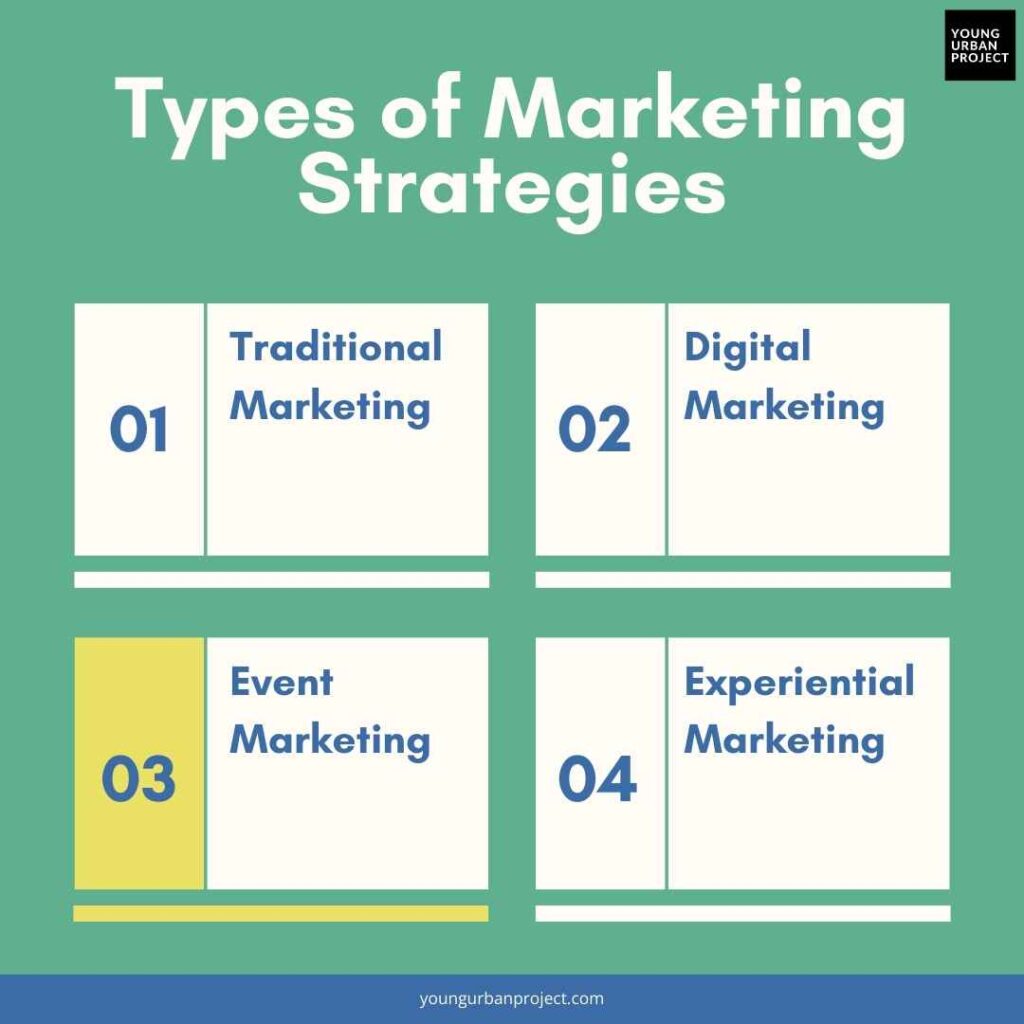
When we talk about marketing strategies, we’re not just referring to a single approach. Successful marketing involves a blend of several strategies, each designed to address specific business needs and goals.
Strategies vary based on the target audience, budget, and the channels available to reach customers. These strategies can be broadly categorized into traditional methods, digital methods, and emerging trends. Let’s explore different types of marketing strategies in more detail.
I. Traditional Marketing
Traditional marketing is the old way of advertising before the internet. It includes things like newspapers, TV, and billboards. Even though online marketing is popular, traditional marketing is still useful. It works well for businesses that target older people or industries that rely on face-to-face interactions. Here are some common traditional marketing methods:
1. Print Advertising
Print advertising includes newspapers, magazines, flyers, and brochures. Many local businesses still use it to reach customers in their area. It is good for targeting specific groups. For example, a fashion magazine ad can reach people interested in fashion. Even though online ads are popular, print ads feel more trustworthy and can leave a lasting impression. They are also useful for people who prefer reading physical materials.
2. Television Advertising
TV ads reach many people at once. Big brands use them to promote their products. A well-made TV ad can create strong emotions and make people remember the brand. TV ads are great for businesses with big budgets. They appear during popular shows, news, and sports events. Although they cost a lot, they can bring many new customers. Small businesses may find them too expensive.
3. Radio Advertising
Radio ads play on FM, AM, and satellite radio stations. They are great for reaching people in cars, at work, or at home. Businesses can choose stations based on their audience. For example, a sports brand can advertise on a sports radio station. Local businesses also use radio ads to attract nearby customers. Since people listen daily, repeated ads help them remember the brand.
4. Billboards and Outdoor Advertising
Billboards, posters, and banners are placed in busy areas like highways and city centers. They grab attention when people drive or walk by. Businesses use them to show short, clear messages. A well-placed billboard can be seen by thousands of people every day. They are good for brand awareness because people see them often. However, they work best when combined with other marketing methods.
II. Digital Marketing
Digital marketing refers to any marketing efforts conducted through digital channels. It leverages the internet, social media, mobile apps, and other online platforms to reach a wide audience. Digital marketing offers businesses the ability to track and measure the effectiveness of their campaigns, making it more cost-effective and efficient than traditional marketing. The Best Business Coach in India will always emphasize the importance of leveraging personal branding and digital marketing to achieve significant growth and brand reputation in your domain. Here are some popular digital marketing strategies:
Here are some popular digital marketing strategies:
1. Search Engine Optimization (SEO)
SEO is the process of optimizing a website’s content, structure, and technical aspects to rank higher on search engine results pages (SERPs) like Google. SEO helps businesses attract organic (non-paid) traffic by ensuring their website is easily discoverable when potential customers search for relevant keywords. However, understanding the advantages and disadvantages of SEO is crucial for businesses to implement effective strategies that yield long-term results.
- On-page SEO: Involves optimizing individual web pages by improving content, headlines, images, and meta descriptions.
- Off-page SEO: Involves activities outside of your website, such as backlink building and social media engagement, to increase the website’s authority.
- Technical SEO: Focuses on improving the technical aspects of a website, like page load speed and mobile responsiveness, to enhance the user experience and search engine rankings.
2. Pay-Per-Click Advertising (PPC)
PPC advertising is a form of paid digital marketing where businesses pay a fee each time their ad is clicked. Platforms like Google Ads, Facebook Ads, and LinkedIn Ads allow businesses to create highly targeted campaigns to reach specific audiences based on their interests, demographics, and online behaviors.
- Search Ads: Appear when users search for specific keywords on search engines like Google.
- Display Ads: Banner or video ads that appear on websites within the Google Display Network.
- Social Media Ads: Ads on platforms like Facebook, Instagram, or Twitter designed to engage users based on their behavior and interests.
PPC can deliver quick results but requires ongoing optimization to ensure cost-effectiveness.
3. Content Marketing
Content marketing focuses on creating and distributing valuable content to attract and engage a target audience. Content can come in many forms, including blog posts, videos, podcasts, eBooks, and infographics. The goal is not just to promote products or services but to provide value that answers customer questions, educates them, or solves their problems.
Content marketing has the potential to build trust, improve brand recognition, and convert visitors into loyal customers. Businesses often use a content calendar to plan their publishing schedule, ensuring consistency and alignment with customer needs.
4. Email Marketing
Email marketing involves sending personalized, targeted emails to your audience with the goal of nurturing leads, increasing engagement, and driving sales. Common types of email campaigns include:
- Newsletter Emails: Regular updates on news, offers, and insights that help keep customers informed and engaged.
- Promotional Emails: Emails that highlight sales, special offers, or new products to drive conversions.
- Abandoned Cart Emails: Emails sent to users who’ve left items in their online shopping cart to encourage them to complete the purchase.
Email allows businesses to segment their audience based on behavior or demographics, ensuring that the right message is sent to the right person at the right time.
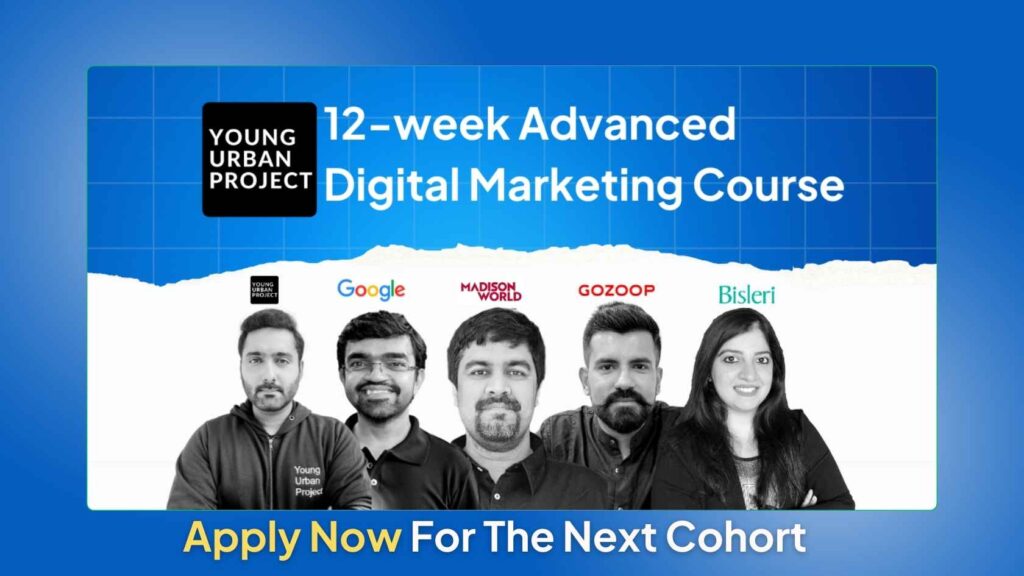
5. Social Media Marketing
Social media marketing is the process of using platforms like Facebook, Instagram, Twitter, LinkedIn, and to connect with your audience, increase brand awareness, and drive traffic to your website. Social media marketing includes organic strategies, like posting regular updates and engaging with followers, as well as paid advertising.
- Organic Social Media: Creating content that resonates with followers to generate engagement (likes, comments, shares) and increase organic reach.
- Paid Social Media Ads: Running targeted ads to drive specific actions, like website visits, lead generation, or product purchases.
Social media offers a two-way communication channel, allowing businesses to receive instant feedback from customers and adjust their strategies accordingly.
6. Influencer Marketing
Influencer marketing is when businesses work with popular people on social media or blogs to promote products. These people, called influencers, have many followers who trust their opinions. They make videos or posts about a product, and their audience listens.
This works well because people trust influencers more than ads. Brands pay influencers to post reviews, unboxing videos, or giveaways. Platforms like Instagram, YouTube, and TikTok are best for this.
7. Affiliate Marketing
Affiliate marketing is when businesses pay people to promote their products. These people, called affiliates, share a special link. If someone buys through that link, the affiliate earns a commission.
Affiliates promote products on blogs, YouTube, or social media. Businesses like this because they only pay when they make sales. It helps brands reach more people without paying for ads upfront. This makes it low-risk marketing.
Also Read: Marketing vs Advertising
III. Event Marketing
Event marketing is when businesses promote their products at events. These can be trade shows, conferences, or workshops. Businesses use events to meet customers, show products, and build their brand.
Online events like webinars and live streams are also popular. They let businesses reach people worldwide. Events help brands connect with people in a personal way, making marketing more effective.
IV. Experiential Marketing

Experiential marketing focuses on creating memorable experiences for customers. It goes beyond traditional advertising and encourages direct participation from the audience. Examples include pop-up shops, interactive product demos, or virtual reality experiences.
Experiential marketing aims to create emotional connections with customers, which can lead to stronger brand loyalty and word-of-mouth promotion.
In 2023, 47% of marketers reported boosting their investments in experiential marketing initiatives (HubSpot State of Marketing Report, 2023).
What Are the 4 P’s of Marketing?
digThe 4 P’s of Marketing provide a foundational framework for creating an effective strategy. These elements cover the key decisions that a business must make when marketing a product or service:
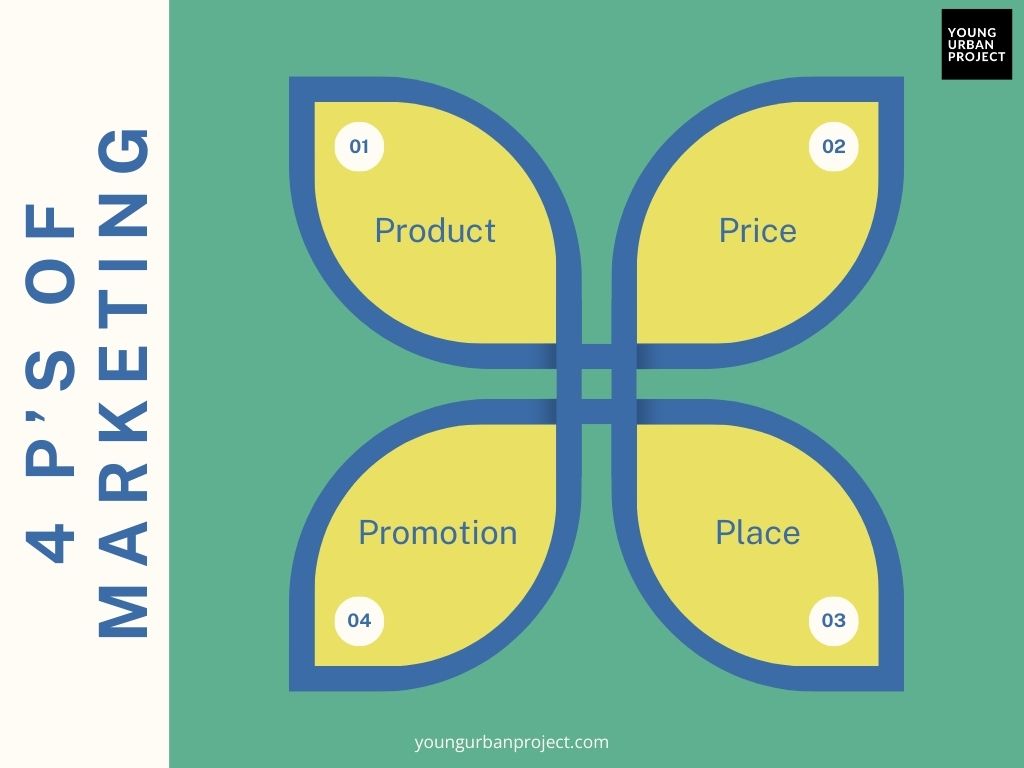
1. Product
The product is the heart of your marketing strategy. It must fulfill a need or solve a problem for your target audience. A solid understanding of your customers’ pain points will guide the development of products that resonate with them.
2. Price
Pricing determines the perceived value of your product and its position in the market. Are you aiming for a premium offering or a more affordable option? Setting the right price is critical to ensuring that your product is competitive while meeting the expectations of your customers.
3. Place
Place refers to where and how your product is made available to customers. This could involve physical retail locations, online stores, or third-party platforms. With the rise of eCommerce, understanding the best distribution channels has never been more important.
4. Promotion
Promotion involves communicating the benefits of your product to the target audience. Whether through digital ads, email campaigns, or influencer partnerships, effective promotion ensures that your audience knows about your product and its value.
Also read: The 5 Ps of Marketing and How to Use Them
Marketing Strategy Framework
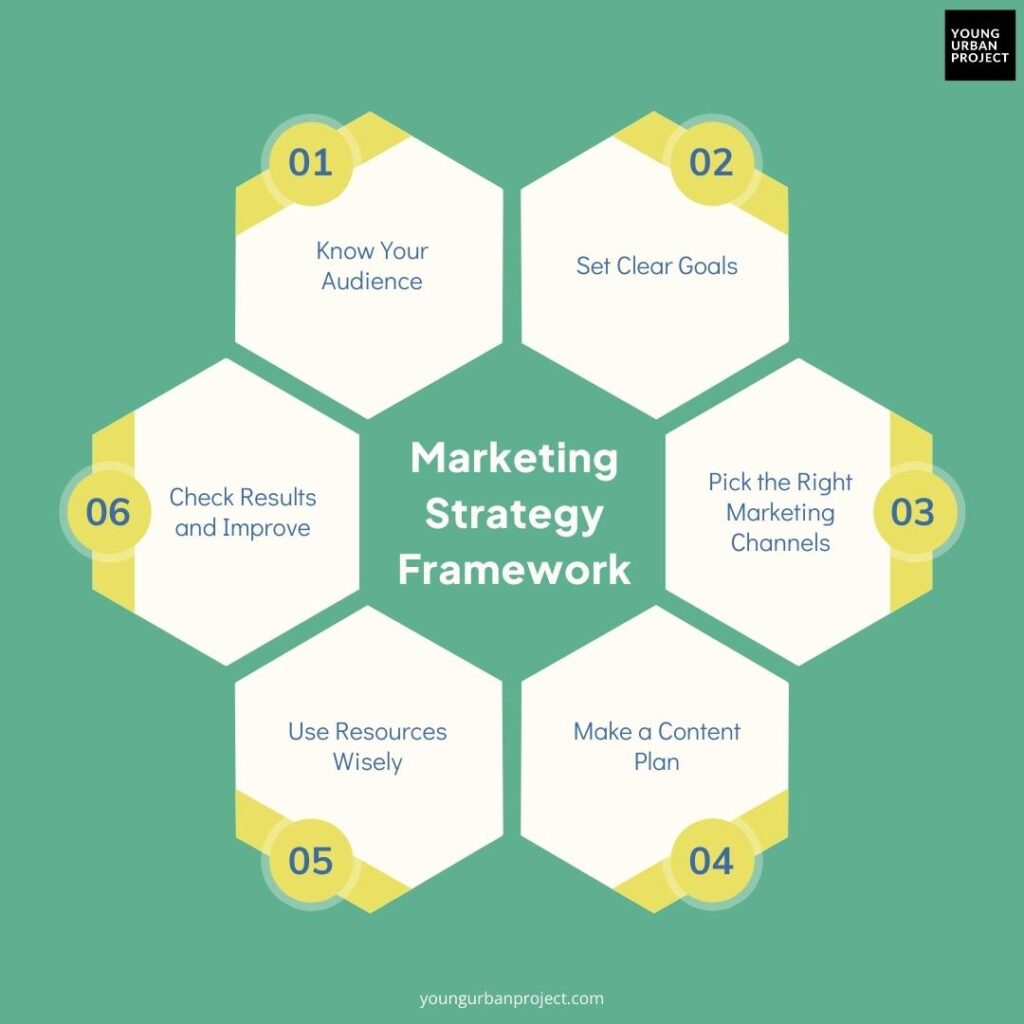
A good marketing strategy is more than just knowing the basics. It needs a clear plan, the right actions, and regular checking. Follow these steps to build a strong strategy:
Step 1: Know Your Audience
The first step is to understand your customers. Find out what they like, what they need, and where they spend their time. Use surveys to ask them questions. Look at social media to see what they talk about. Check website data to learn their interests. When you know your audience well, you can create marketing that speaks directly to them.
Step 2: Set Clear Goals
Before you start marketing, decide what you want to achieve. Do you want more people to know about your brand? Do you want more sales? Or do you want new customers? Setting clear goals helps you focus. It also makes it easier to measure if your marketing is working or not. Make sure your goals match your business needs.
Step 3: Pick the Right Marketing Channels
Not every marketing method works for every business. Choose where to share your message based on where your audience spends time. Social media, email, websites, and ads are common options. Some businesses also use print, TV, or events. The right channels will help you reach the right people and get better results.
Step 4: Make a Content Plan
Content is what attracts and keeps customers interested. Create helpful blog posts, fun videos, or social media updates. Make sure your content is useful and easy to understand. A good content plan keeps everything organized. Plan what to post and when. This helps you stay consistent and keeps your audience engaged.
Step 5: Use Resources Wisely
Marketing takes time, money, and effort. Decide how much you can spend. Use your budget on things that bring good results. Focus on marketing that helps you reach your goals. If something is not working, don’t waste time on it. A smart budget will help you get the most out of your efforts.
Step 6: Check Results and Improve
Marketing doesn’t stop after you post something. You must track results. Look at how many people visit your website, click your ads, or buy your product. Use tools like Google Analytics to see what works best. If something is not working, change your plan. Always look for ways to improve your strategy.
Why is Marketing Important for Business?
To know why is marketing important for businesses, we have to know understand that marketing is more than just a way to push products or services to consumers. It’s the bridge between your business and the outside world. It’s how you connect with your target audience, build relationships, and, ultimately, drive revenue. Marketing is crucial to every business, regardless of size or industry, because it serves as the foundation for growth, brand loyalty, and customer engagement. In a world where consumer behavior and technology are constantly evolving, it ensures that your brand stays relevant and resonates with your audience.
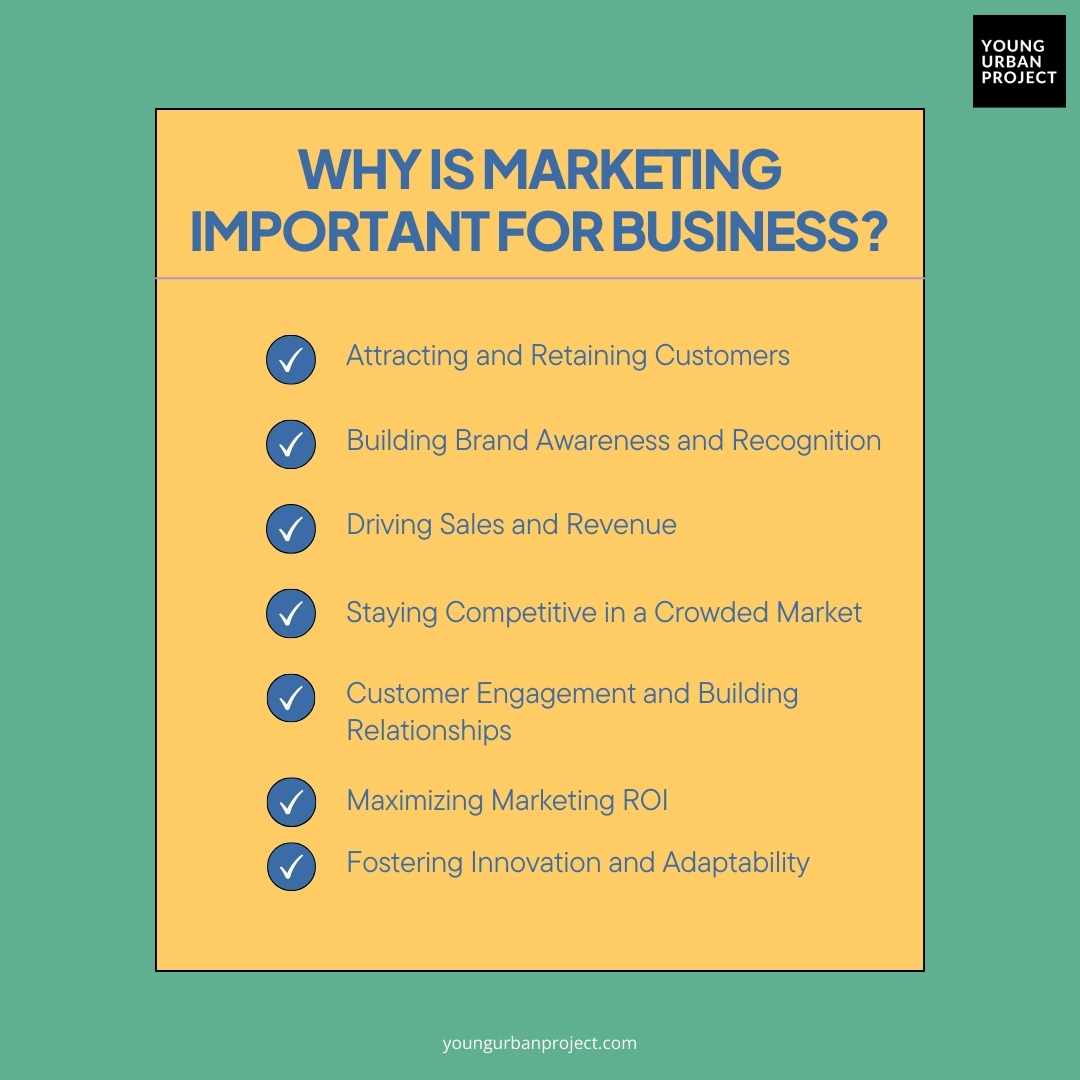
1. Attracting and Retaining Customers
One of the core functions of marketing is customer acquisition and retention. In a 2024 global survey of marketers, around 83 percent cited increased exposure as a key benefit of social media marketing. Without effective marketing, customers may not even know your business exists, or worse, they may forget about you as new competitors emerge. It ensures that your brand stays top-of-mind through strategies like social media, SEO, and advertising.
For instance, Companies with active blogs generate an average of 67% more leads per month compared to those without blogs. This shows the cost-efficiency of keeping customers engaged through continuous value-driven efforts. Retaining a customer is also more cost-effective than acquiring a new one—customer retention can be up to 5 times cheaper than customer acquisition, according to a report by Invesp. This means that marketing not only helps bring in new clients but also nurtures your existing customer base to ensure they remain loyal.
2. Building Brand Awareness and Recognition
Marketing is the driving force behind building your brand’s identity and recognition. When people are aware of your brand, they’re more likely to trust you and make purchases. Brand recognition is essential in an age where consumers are constantly bombarded with messages from all sides.
In a study by Nielsen, 59% of consumers prefer to buy products from brands they trust, highlighting the importance of marketing in cultivating trust. Effective marketing efforts, such as strong branding and consistent messaging, help businesses create memorable impressions. Whether it’s through traditional methods like TV ads or modern marketing channels like influencer partnerships and social media, marketing fosters emotional connections that make customers choose your product over a competitor’s.
With visual platforms like Instagram and YouTube, content marketing has become a key tool for building brand recognition. Marketers can now reach audiences with eye-catching visuals and compelling narratives that tell a story about the brand.
3. Driving Sales and Revenue
One of the most direct outcomes of effective marketing is an increase in sales and revenue. Marketing drives demand, which in turn drives sales. For example, a report from WordStream reveals that the typical ROI for Facebook Ads is 9.21%, meaning businesses earn $9.21 for every $1 spent on Facebook Ads.
Moreover, marketing isn’t just about selling more products or services. It’s also about understanding your customers’ needs and positioning your offerings as the solution to their problems. By employing customer-centric marketing strategies, businesses can identify pain points, create tailored offers, and convert prospects into loyal customers.
Also read: The Difference Between Selling and Marketing
4. Staying Competitive in a Crowded Market
Today, many businesses are trying to attract the same customers. New companies start every day, and customer preferences change fast. Marketing helps businesses stay ahead by understanding trends and customer needs.
People expect businesses to offer a personal experience. A report by HubSpot says 75% of customers want this. Many companies use technology to make marketing more personal.
Good marketing helps businesses study competitors and find ways to stand out. It also helps them explain why their products are better. This is important for success in a busy market.
For example, Nike does not just sell sportswear. It markets itself as a lifestyle brand. It uses personal messages, sponsors athletes, and creates emotional ads. This helps it stay ahead, even with strong competition.
5. Improving Customer Engagement and Building Relationships
Marketing helps businesses foster a deeper relationship with their customers. It’s no longer just about pushing out messages and hoping they resonate. Today’s marketing is about creating meaningful dialogues and building trust with the audience. Through social media, businesses can respond to customers in real-time, address concerns, and gather feedback. According to Sprout Social, 64% of consumers want brands to connect with them on social media, making it a crucial platform for engagement.
Personalized marketing also plays a key role in enhancing customer engagement. With tools like email marketing and retargeting ads, businesses can create tailored experiences for customers based on their preferences and browsing behavior. This level of personalization encourages customer loyalty and repeat purchases.
6. Maximizing Marketing ROI
Every dollar spent on marketing should contribute to business growth. Marketing ensures that businesses are not only able to track their spending but also measure their return on investment (ROI). Digital marketing channels like Google Analytics, social media insights, and email marketing platforms provide real-time data, allowing businesses to see which strategies are working and which are not.
This data-driven approach enables businesses to make informed decisions and optimize their marketing efforts to maximize ROI.
7. Fostering Innovation and Adaptability
Marketing helps businesses adapt to changing market dynamics and consumer trends. It encourages companies to continuously innovate by responding to consumer feedback, analyzing new technologies, and staying ahead of market shifts. Whether it’s through implementing AI in customer service, adopting voice search optimization, or exploring new social platforms like Instagram, marketing encourages businesses to stay relevant and forward-thinking.
Marketing teams are often the driving force behind these innovations, leading businesses to explore new ways to engage with their audience.
Also Read: Importance of Marketing Management
Challenges of Marketing
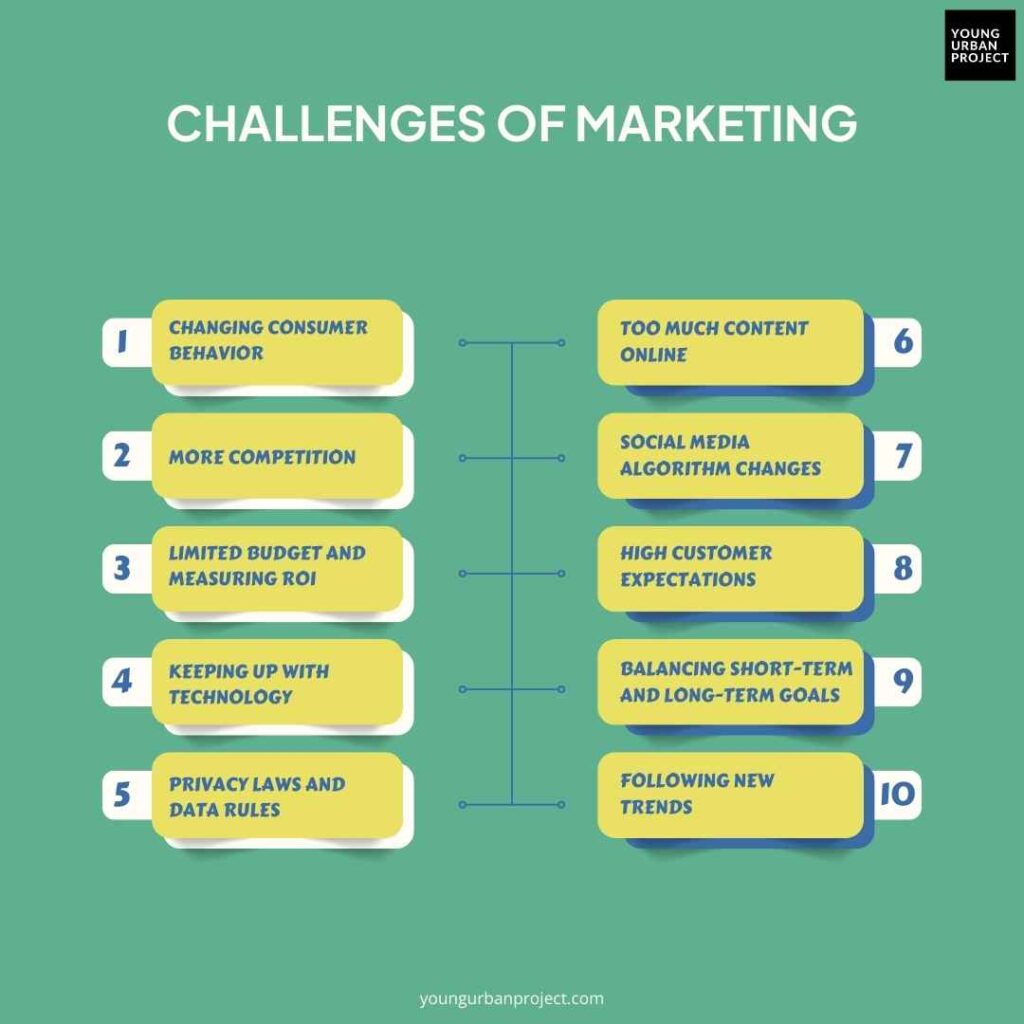
Marketing is not easy. Businesses must deal with changing customer behavior, high competition, and new technology. Here are the biggest challenges and how to solve them.
1. Changing Consumer Behavior
People’s interests change fast. Social media, trends, and new technology affect what they like. Businesses must study their customers often to understand them.
Tools to help:
- Google Analytics – Tracks website visitors and their actions.
- Brandwatch – Monitors social media trends and consumer opinions.
- AnswerThePublic – Shows what people are searching for online.
2. More Competition
Many businesses sell similar products. It is harder to stand out. Companies must have a clear message and offer something special.
Tools to help:
- SEMrush – Helps improve website ranking on Google.
- Ahrefs – Finds keywords and tracks competitors.
3. Limited Budget and Measuring ROI
Marketing costs money. Businesses need to know if their spending brings good results. ROI (Return on Investment) must be measured carefully.
Tools to help:
- Google Analytics – Tracks website visits and conversions.
- HubSpot – Measures leads and sales from marketing.
- Google Ads & Facebook Ads Manager – Show ad performance and spending.
- Kissmetrics – Analyzes customer behavior and sales data.
Enroll Now: Performance Marketing Training
4. Keeping Up with Technology
New technology like AI and automation changes marketing. Businesses must learn and use these tools wisely.
Tools to help:
- ChatGPT – Provides AI-powered customer support.
- HubSpot – Automates email marketing and customer engagement.
- Salesforce – Helps manage customer relationships.
5. Privacy Laws and Data Rules
Laws like GDPR and CCPA protect customer data. Businesses must follow these rules or face fines. They must also collect data safely and legally.
Tools to help:
- OneTrust – Helps businesses follow data privacy laws.
- TrustArc – Manages customer data and legal compliance.
6. Too Much Content Online
People see a lot of ads and content daily. It is hard to grab their attention. Businesses must create unique, useful, and interesting content.
Tools to help:
- BuzzSumo – Finds trending topics that people like.
- Canva – Makes professional-looking images and designs.
- Grammarly – Helps write clear and error-free content.
7. Social Media Algorithm Changes
Social media platforms often change how they show posts. Organic reach is lower, so businesses must focus on engagement and paid ads.
Tools to help:
- Sprout Social – Tracks social media performance and audience behavior.
- Later – Helps schedule and plan social media content.
- Hootsuite – Manages social media posts and engagement.
8. High Customer Expectations
Customers want quick replies and personal service. They expect fast, helpful, and smooth interactions on every platform.
Tools to help:
- Drift – Uses AI chatbots to answer customer questions fast.
- Intercom – Helps businesses chat with customers in real time.
- Salesforce – Stores customer data and helps personalize marketing.
9. Balancing Short-Term and Long-Term Goals
Some businesses focus only on short-term sales. But long-term brand-building is important too. It helps create loyal customers and steady growth.
Tools to help:
- Google Trends – Shows long-term trends in customer interest.
- Brandwatch – Monitors brand reputation and customer feedback.
- Pardot – Helps build long-term customer relationships.
10. Following New Trends
New marketing trends like influencer marketing and voice search appear all the time. Not all trends work for every business. Companies must choose wisely.
Tools to help:
- Trendspottr – Finds upcoming trends in marketing.
- Google Search Console – Helps optimize websites for voice search.
Also read: Principles of Marketing
Latest Marketing Trends for Businesses
1. Artificial Intelligence (AI) in Marketing
AI is changing how businesses do marketing. It helps companies understand customers better, predict trends, and create personalized experiences. AI tools can analyze large amounts of data quickly. This helps businesses send the right message to the right people at the right time.
Chatbots are another example of AI in marketing. They provide instant replies to customers, improving customer service. AI can also create content, suggest product recommendations, and even manage social media posts. For example, Netflix and Amazon use AI to suggest movies or products based on past behavior. AI makes marketing more efficient and helps businesses connect with customers in a smarter way.
2. Influencer Marketing Growth
Influencer marketing is becoming more popular. People trust recommendations from real people more than traditional ads. Brands work with influencers on platforms like Instagram, TikTok, and YouTube to promote their products. These influencers have a loyal following, making their recommendations powerful.
Micro-influencers (with smaller audiences) are now in demand. They often have more engaged followers and cost less than big influencers. Businesses also focus on long-term relationships with influencers instead of one-time promotions. For example, beauty brands partner with makeup artists to showcase new products. Influencer marketing feels more personal and helps businesses build trust with potential customers.
3. Personalization in Marketing
Customers want brands to understand their needs. Personalization means showing people the right content, offers, or ads based on their interests. Companies use data from browsing history, past purchases, and customer preferences to personalize experiences.
For example, when you visit an online store, you might see product recommendations based on what you looked at before. Email marketing is also more personalized now. Instead of sending the same email to everyone, businesses send customized messages based on what customers like. Companies like Spotify and Amazon use personalization to improve user experience. It makes customers feel special and increases the chances of them buying something.
4. Short-Form Video Content
Videos are becoming the most popular way to consume content online. Platforms like TikTok, Instagram Reels, and YouTube Shorts are growing fast. Short videos grab attention quickly and are easy to watch. Businesses use them to showcase products, share tips, or entertain their audience.
Short-form videos don’t need high production quality. Even simple videos recorded on a phone can go viral if they are engaging. Many brands use storytelling in their videos to connect with people emotionally. For example, food brands share quick recipe videos, while fashion brands show outfit ideas. Video marketing is an effective way to reach more people and keep them interested.
5. Voice Search and Smart Assistants
More people are using voice search to find information. Devices like Alexa, Google Assistant, and Siri have changed how customers search for products and services. Instead of typing, people ask questions out loud. This means businesses need to change how they optimize their websites.
For voice search, businesses should use simple and natural language. People usually ask complete questions, like “Where is the best pizza place near me?” instead of just typing “best pizza.” Companies also need to focus on local SEO because many voice searches are for nearby businesses. By adapting to voice search, brands can reach more customers and improve their online visibility.
6. Social Commerce is Growing
Social media platforms are now becoming shopping platforms. Customers can buy products directly from Instagram, Facebook, TikTok, and Pinterest without leaving the app. This trend is called social commerce. It makes shopping faster and easier for users.
Businesses use features like Instagram Shops, Facebook Marketplace, and TikTok Shopping to sell products. Influencers also play a big role in social commerce by reviewing and promoting items. Many brands use live shopping, where influencers showcase products in real time. Customers can ask questions and buy immediately. Social commerce helps businesses increase sales by making shopping a smooth and engaging experience.
Also read: What is Marketing Mix Modeling (MMM)?
Building Strong Customer Loyalty with Targeted Marketing
1. Personalization
People like brands that understand them. They expect businesses to remember their past purchases and recommend things they need. A study by Epsilon found that 80% of customers are more likely to buy from brands that offer personalized experiences.
How to Do It:
- Send personalized emails with product recommendations.
- Offer discounts based on past purchases.
- Use AI chatbots to suggest products based on browsing history.
Example:
Amazon uses customer data to suggest products based on past purchases and browsing habits. This makes shopping easier and more personal.
2. Customer Segmentation
Not all customers are the same. Businesses should divide them into groups based on their interests, behavior, or location. This helps send the right message to the right people.
Ways to Segment Customers:
- Demographics: Age, gender, location.
- Behavior: Past purchases, website visits, social media activity.
- Psychographics: Interests, values, lifestyle.
How to Do It:
- Offer exclusive discounts to loyal shoppers.
- Show different ads to different groups.
- Send special offers to first-time buyers.
Example:
Nike targets athletes and fitness lovers with performance-focused ads, while also promoting casual wear to everyday customers.
3. Emotional Connection
Loyalty isn’t just about products—it’s about relationships. Customers connect with brands that share their values.
How to Do It:
- Support causes your customers care about.
- Show real customer stories in your marketing.
- Be authentic and relatable in your messaging.
Example:
Dove builds strong emotional connections by promoting body positivity and self-confidence in its campaigns.
4. Reward Programs
Loyalty programs encourage customers to keep coming back. A report by Merkle found that 79% of customers stay with brands that offer rewards.
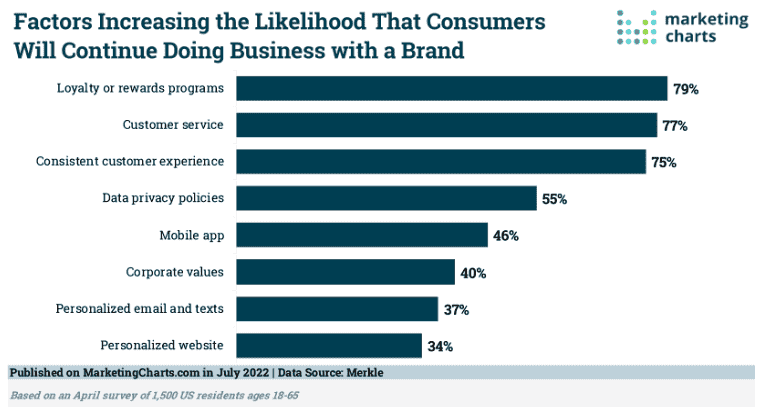
How to Do It:
- Give points for every purchase.
- Offer exclusive rewards to loyal customers.
- Provide early access to new products.
Example:
Starbucks Rewards lets customers earn free drinks and get special offers based on their purchase history.
6. Exclusive Access and VIP Treatment
Customers appreciate feeling valued. Offering exclusive access to products, services, or experiences can make them feel special and strengthen their bond with the brand.
How to Do It:
- Early Access to Products: Let VIP customers buy new items before they are released to the public.
- Exclusive Discounts: Offer private sales, special birthday discounts, or limited-time promotions.
- Premium Customer Service: Provide faster shipping, priority support, or concierge services for high-value customers.
Example:
Sephora’s Beauty Insider program rewards loyal customers with free samples, birthday gifts, and early access to sales. The more they shop, the better rewards they get, encouraging repeat purchases.
7. Customer Feedback and Involvement
Loyalty grows when customers feel heard. When businesses listen and act on customer feedback, it builds trust and strengthens the relationship.
How to Do It:
- Surveys & Polls: Ask customers about their preferences and experiences through emails or website pop-ups.
- Product Testing Programs: Offer loyal customers a chance to try new products before launch and give feedback.
- Publicly Respond to Feedback: Address concerns in product reviews, social media comments, or email responses.
Example:
Tesla updates its car software based on customer feedback. They use online surveys and social media discussions to improve features, making customers feel like part of the brand’s journey.
8. Omnichannel Experience
Today’s customers interact with brands in different ways—on websites, in stores, on social media, and through apps. A seamless experience across all channels keeps them engaged.
How to Do It:
- Unified Branding: Make sure the website, app, emails, and social media pages all have the same look, tone, and message.
- Smooth Shopping Experience: Allow customers to browse online, buy in-store, or return items through any channel.
- Multiple Customer Support Options: Offer help through live chat, email, phone, and social media.
Example:
Apple provides a seamless experience between its online store, physical stores, and customer support. A customer can order a product online, pick it up in-store, and get help through Apple Support—all with the same smooth experience.
9. Predicting Customer Needs
Brands that can anticipate customer needs create a deeper sense of connection. Predictive analytics helps businesses understand what customers might want before they even ask.
How to Do It:
- Personalized Product Suggestions: Use past purchases and browsing history to recommend relevant items.
- Subscription & Refill Reminders: Send notifications when a product is likely to run out and offer a convenient reorder option.
- Seasonal or Event-Based Offers: Provide timely recommendations for holidays, birthdays, or other special occasions.
Example:
Netflix analyzes what users watch and suggests content they might like. This keeps users engaged and makes them feel like the platform understands their preferences.
10. Transparency and Trust
Trust is one of the biggest factors in customer loyalty. People want to buy from brands that are honest about their products, pricing, and business practices.
How to Do It:
- Clear Pricing & Policies: Avoid hidden fees and make return policies easy to understand.
- Ethical Business Practices: Be open about sourcing, labor conditions, and sustainability efforts.
- Honest Marketing: Avoid misleading claims and be upfront about what products can and can’t do.
Example:
Patagonia is known for its transparency. The company shares information about how its clothes are made, its sustainability efforts, and its environmental impact. Customers trust the brand because it aligns with their values.
Best Ways to Track Marketing Success
1. Monitor Website Traffic
A website is one of the main places where customers interact with a business. Tracking website traffic helps businesses understand how many people visit, where they come from, and what they do on the site. Google Analytics is a great tool for this.
It shows details like page views, time spent on the site, and bounce rate (when people leave quickly). Businesses can see which marketing efforts bring the most visitors. For example, if a company runs a social media ad, they can check how many people clicked the ad and visited the website. Tracking website traffic helps businesses improve their marketing and attract more customers.
2. Measure Conversion Rates
Getting website visitors is good, but what really matters is how many take action. A conversion happens when a visitor does something valuable, like making a purchase, signing up for a newsletter, or filling out a contact form.
Tracking conversion rates helps businesses see if their marketing efforts are working. For example, if 1,000 people visit a website and 50 buy something, the conversion rate is 5%. Google Analytics and marketing platforms like HubSpot can track conversions. If the conversion rate is low, businesses might need to improve their website, offers, or ad campaigns to make them more effective.
3. Analyze Social Media Engagement
Social media is a big part of marketing. Tracking likes, comments, shares, and follower growth shows how well a business is connecting with its audience. High engagement means people are interested in the content.
Businesses can use tools like Meta (Facebook) Insights, Instagram Analytics, and TikTok Analytics to track performance. They can see which posts get the most attention and what type of content works best. If a business notices that videos get more shares than photos, they can focus on creating more videos. Social media engagement helps businesses adjust their strategy and build stronger connections with customers.
4. Track Email Marketing Performance
Email marketing is an effective way to reach customers. Tracking email performance shows if people are reading, clicking, and responding to emails. Important metrics include open rate, click-through rate (CTR), and unsubscribe rate.
For example, if 1,000 people receive an email and 200 open it, the open rate is 20%. If only a few people click on links inside the email, the business might need to improve subject lines or email content. Email platforms like Mailchimp and HubSpot provide detailed reports on email performance. By tracking results, businesses can send better emails and increase customer engagement.
5. Check Return on Investment (ROI)
Marketing costs money, so businesses need to know if their spending is worth it. Return on investment (ROI) measures how much money a business earns compared to how much they spend on marketing.
For example, if a company spends $1,000 on ads and makes $5,000 in sales, the ROI is positive. But if they only make $800, they are losing money. Tools like Google Ads, Facebook Ads Manager, and CRM software help track ROI. If a marketing campaign has a low ROI, businesses may need to change their strategy or invest in different channels that bring better results.
6. Use Customer Feedback and Surveys
Numbers and data are important, but listening to customers gives deeper insights. Surveys and feedback help businesses understand what customers like, dislike, and expect.
Businesses can send surveys through email, websites, or social media. They can ask customers if they are happy with a product, what they think about a recent ad, or how they heard about the brand. Tools like Google Forms, Typeform, and SurveyMonkey make it easy to collect feedback. When businesses understand customer opinions, they can improve their marketing and build stronger relationships with their audience.
Also read: What Is Marketing Management?
Conclusion
In conclusion, the importance of marketing is undeniable. It’s the cornerstone of business growth, customer engagement, and brand loyalty. It helps businesses stand out in a competitive landscape, connecting with customers in meaningful ways. Whether through traditional advertising or digital strategies like social media and SEO, the goal remains the same: to build lasting relationships and drive sales.
Marketing isn’t just about attracting new customers; it’s about building lasting relationships, creating exceptional customer experiences, and positioning your brand as a leader in the industry. With the rise of data-driven insights, businesses can fine-tune their strategies to deliver personalized, impactful campaigns that resonate with their target audience.
While challenges like keeping up with trends and managing budgets exist, they can be overcome with agility and innovation. Marketing is not just a tool; it’s a vital driver of success. By embracing marketing’s full potential, businesses can stay relevant, grow sustainably, and thrive in an ever-changing market.
FAQs: Importance of Marketing
Why is marketing important for businesses?
Marketing connects businesses with their target audience, ensuring visibility and sales. It builds brand awareness, fosters customer relationships, and drives business growth. Without marketing, even great products or services may go unnoticed, limiting success. Effective marketing helps businesses stay relevant and competitive in an ever-changing marketplace.
What are the benefits of marketing?
Marketing increases brand recognition, attracts new customers, and boosts sales. It helps businesses understand market trends, improve customer engagement, and foster loyalty. Additionally, marketing drives innovation by encouraging companies to adapt to customer needs. A well-executed marketing strategy can significantly enhance a business’s profitability and long-term sustainability.
How do I create a marketing plan for my business?
Start by defining your target audience and setting clear goals. Research competitors, choose the right marketing channels, and develop a unique value proposition. Create a content strategy, allocate a budget, and implement campaigns. Regularly monitor performance and adjust strategies based on analytics to maximize effectiveness and ROI.
Why should I invest in marketing for my business?
Marketing is an investment in your business’s growth and success. It attracts customers, strengthens brand loyalty, and keeps you competitive. A strategic marketing approach ensures your business remains visible in a crowded market. Without it, potential customers may choose competitors, leading to missed opportunities and slower business expansion.
How do businesses measure the success of their marketing efforts?
Businesses track marketing success using key performance indicators (KPIs) such as website traffic, conversion rates, customer engagement, and sales growth. Tools like Google Analytics and social media insights help measure effectiveness. Return on investment (ROI) analysis ensures marketing efforts generate tangible value for the business.
What are the latest marketing trends I should know about?
Personalization, AI-driven marketing, and short-form video content dominate current trends. Social commerce, influencer marketing, and sustainability-focused branding are also gaining traction. Businesses must leverage data-driven strategies and emerging technologies to stay ahead. Adapting to these trends helps improve engagement, brand loyalty, and overall marketing effectiveness.
What are common marketing mistakes businesses should avoid?
Avoid unclear messaging, ignoring target audience research, and inconsistent branding. Failing to track performance, neglecting digital marketing, and overlooking customer feedback can also harm success. Businesses should focus on data-driven strategies, engage with their audience effectively, and continuously optimize their marketing efforts for long-term growth.
What are some examples of effective marketing strategies?
Successful marketing strategies include content marketing (blogs, videos, and infographics), social media marketing, SEO, influencer collaborations, and personalized email campaigns. Traditional methods like print ads and billboards still work, but digital strategies offer better targeting and tracking. A well-balanced approach combining multiple strategies ensures maximum reach and engagement.
What is the difference between traditional and digital marketing?
Traditional marketing includes offline channels like TV, radio, newspapers, and billboards, reaching broad audiences but with limited tracking. Digital marketing leverages online platforms like social media, SEO, email, and PPC ads, offering precise targeting and real-time analytics. Digital marketing is more cost-effective, flexible, and measurable, making it the preferred choice for modern businesses.

